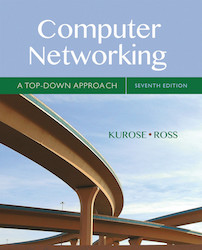Popular Computer Networking Textbook by Keith Ross Enters Seventh Printing
 Computer Networking: A Top-Down Approach, 7th Edition
Computer Networking: A Top-Down Approach, 7th Edition
By James F. Kurose and Keith W. Ross
Pearson, 2016
NYU Professor Keith Ross’s blockbuster computer networking textbook, Computer Networking: A Top-Down Approach, has entered its seventh printing. It is the most popular computer networking textbook, and has been translated into 14 languages: English, French, Spanish, German, Italian, Portuguese, Dutch, Greek, Polish, Russian, Chinese, Korean, Japanese, and Turkish.
First published in 1999, the textbook is designed to provide an introduction to computer networking. It upends the traditional pedagogy, which long dictated that the subject be taught with a bottom-up approach — starting with the physical layer of network architecture and moving to the application layer.
Ross and co-author James F. Kurose were the first to advocate a “top-down” approach, which emphasizes the application layer, where most of the recent revolutions in networking have taken place, from web browsers to peer-to-peer file sharing, media streaming and mobile applications. Recent editions reflect advances in wireless networking and router architectures, cloud computing services, multimedia networking, and the Internet of Things.
Ross is the Leonard J. Shustek Professor of Computer Science and Engineering at the NYU Tandon School of Engineering and Dean of Engineering and Computer Science at NYU Shanghai. His research group has published extensively on Internet privacy, security and piracy; peer-to-peer networks, and video distribution on the Internet. He is a fellow of the Association for Computing Machinery and the Institute of Electrical and Electronics Engineers (IEEE), recipient of the Infocom 2009 Best Paper Award, and recipient of the 2008 and 2011 Best Paper Awards for Multimedia Communications from the IEEE Communications Society. Kurose, a professor at University of Massachusetts, Amherst, leads the National Science Foundation Directorate of Computer and Information Science and Engineering.




